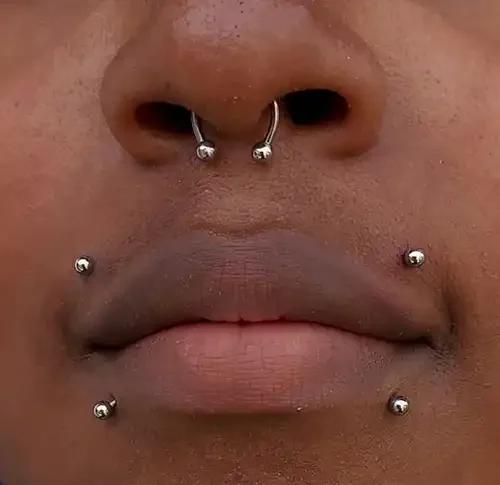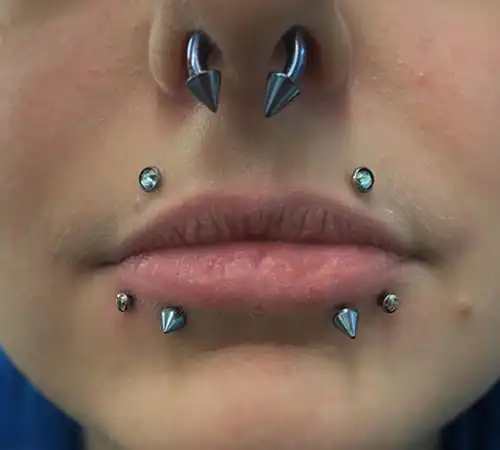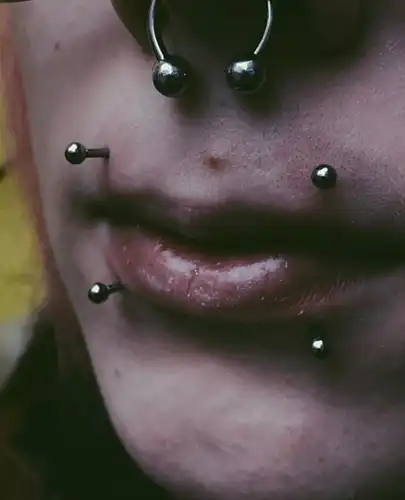Canine Bites Piercing in Nairobi, Kenya
Canine bites are a type of lip piercing that consists of four individual piercings placed around the lips, resembling the position of a dog’s canine teeth. These piercings are a combination of both angel bites (two piercings above the upper lip) and snake bites (two piercings below the lower lip), creating a symmetrical look.

Canine Bites Piercing
Canine Bites Piercing Procedure
The procedure for getting canine bites piercings is quite similar to other lip piercings but involves four separate punctures. Here’s a step-by-step overview of what to expect during the procedure:
- Consultation and Preparation
– Consultation: You’ll have a consultation with our piercer to discuss the placement, jewelry options, and any concerns you may have. Our piercer will check your lip anatomy to ensure the piercings can be placed symmetrically and safely.
– Sterilization: Our piercer will thoroughly clean and sterilize the area around your lips. They will also prepare the necessary tools and jewelry, ensuring everything is sterile. - Marking the Placement
– Marking: The piercer will use a surgical marker to mark the exact spots where the piercings will be placed. You’ll have a chance to check the placement in a mirror and make adjustments if needed. It’s important to ensure that the marks are symmetrical for a balanced look. - Piercing Process
– Piercing the Upper Lip: The procedure typically begins with the upper lip. Our piercer will use a hollow needle to create the first piercing on one side of the upper lip, followed by the second piercing on the other side.
– Piercing the Lower Lip: Our piercer will then move on to the lower lip, repeating the process for the remaining two piercings. Each piercing is done separately to ensure precision.
– Inserting Jewelry: After each hole is made, our piercer will immediately insert the chosen jewelry, usually a labret stud or a small ring. - Aftercare Instructions
– Cleaning: Our piercer will clean the pierced area and provide you with aftercare instructions. This usually includes how to clean the piercings, what to avoid, and signs of infection to watch out for.
– Swelling and Pain Management: You may experience some swelling and discomfort immediately after the procedure. Our piercer might recommend an anti-inflammatory like ibuprofen and suggest using cold compresses to reduce swelling. - Healing and Follow-Up
– Healing Time: The healing process typically takes about 6-12 weeks. During this time, it’s important to follow the aftercare instructions closely to prevent infection and ensure proper healing.
– Check-Ups: Our piercer may recommend a follow-up visit to check on the healing progress and make sure everything is going smoothly. If you experience any complications, such as excessive swelling, redness, or discharge, you should contact our piercer immediately. - Key Considerations:
– Pain: The pain level varies depending on your pain tolerance, but since this involves four piercings, it may be more intense than a single lip piercing.
– Swelling: Swelling is common with lip piercings, and it might be more noticeable with four piercings. Using longer jewelry initially can accommodate the swelling.
– Oral Hygiene: Keeping the area clean is crucial. Avoid touching the piercings with unwashed hands and rinse your mouth with saline solution or an alcohol-free mouthwash after eating.
Considerations before getting a Canine Bites Piercing
Before getting canine bites piercings, it’s important to weigh several considerations. These piercings are visually striking, but they also require significant commitment in terms of care, pain tolerance, and potential impacts on oral health. Here’s what you should consider:
- Pain and Procedure
– Pain Level: Canine bites involve four individual lip piercings, which means the pain is likely to be more intense compared to getting a single or even double lip piercing. Each puncture contributes to cumulative discomfort, so be prepared for that.
– Healing Process: With four piercings, the healing process can be more demanding. Lip piercings typically take 6-12 weeks to heal fully, but healing time may vary depending on how well you follow aftercare instructions and your body’s healing ability. - Aftercare Requirements
– Complex Aftercare: Canine bites require diligent aftercare. You’ll need to clean the piercings with a saline solution 2-3 times a day, rinse your mouth after eating, and avoid irritating the area. Neglecting aftercare increases the risk of infection and complications.
– Swelling and Discomfort: Swelling is common, and it may be more pronounced with multiple piercings. Expect to manage discomfort during the initial healing phase, including avoiding certain foods and activities. - Oral Health Risks
– Gum Recession: Lip piercings can cause gum recession if the jewelry rubs against your gums over time. This can lead to gum damage and, in severe cases, tooth loss.
– Enamel Wear: Constant contact between the jewelry and your teeth can wear down enamel, leading to sensitivity and other dental issues.
– Speech and Eating Adjustments: Initially, you may find it difficult to speak or eat comfortably due to the presence of the jewelry. This is especially true when the area is swollen. - Lifestyle Considerations
– Work or School Policies: If you work in an environment with dress code restrictions, visible piercings might not be allowed. It’s essential to check your workplace or school’s policies before committing.
– Social Perceptions: While personal style is subjective, facial piercings can sometimes attract attention or judgment. Consider how this might impact your daily interactions in both professional and social settings. - Cost
– Price: Since canine bites involve four piercings, they can be more expensive than standard piercings. The cost will include the procedure, jewelry, and potentially follow-up visits. Prices vary depending on location and the reputation of the piercer.
– Quality of Jewelry: Investing in high-quality, hypoallergenic jewelry (like titanium or surgical steel) is crucial to avoid allergic reactions and promote healing. - Choosing the Right Piercer
– Experience and Hygiene: Make sure to choose a professional piercer who is experienced with complex piercings like canine bites. Verify that the studio follows strict hygiene protocols and uses sterilized equipment.
– Portfolio and Reviews: Check the piercer’s portfolio and read customer reviews to assess their skill level and consistency. You want a piercer who can ensure symmetrical placement and minimize the risk of complications. - Potential Complications
– Infection: Lip piercings are prone to bacterial infections, especially if not properly cleaned. Signs include excessive redness, swelling, pus, or throbbing pain. Infections can lead to scarring or other health issues if left untreated.
– Rejection and Migration: In rare cases, the body might reject the piercings, causing the jewelry to move or migrate. This can result in uneven placement or the need to remove the jewelry altogether. - Long-Term Commitment
– Maintenance: Even after the initial healing, maintaining healthy piercings requires consistent care. Periodic cleaning and attention to your oral health are essential for the longevity of the piercings.
– Scarring: If you decide to remove the piercings later, there’s a risk of visible scarring at the puncture sites. Scars can vary in size depending on how long you had the piercings and your body’s healing process.
Getting canine bites piercings is a bold choice that comes with both aesthetic appeal and significant responsibility. Being aware of the risks, aftercare requirements, and potential impacts on your oral health will help you make an informed decision.
Canine Bites Piercing Pain and Healing
The pain and healing process for canine bites piercings are important factors to consider before committing to this piercing style. Here’s a detailed overview of what to expect:
Pain Level of Canine Bites Piercings
- Overall Pain: Canine bites involve four separate piercings (two on the upper lip and two on the lower lip), so the overall pain will be more intense compared to a single or double lip piercing.
- Pain Sensitivity Areas: The upper and lower lip areas are sensitive due to the nerve endings and soft tissue involved. You may feel a sharp pinch during each piercing, followed by a throbbing sensation as the needle passes through.
- Cumulative Discomfort: Since this involves multiple punctures in one sitting, the cumulative discomfort can be challenging, especially for those with low pain tolerance. The pain may increase with each piercing as your lips become more sensitive.
- Pain During Healing: You can expect some soreness, tenderness, and swelling for the first few days after getting the piercings. The pain usually subsides as the healing process progresses, though some discomfort might persist during the first few weeks.
Healing Process for Canine Bites Piercings
- Healing Time: The average healing time for lip piercings is 6-12 weeks, but it may take longer depending on individual factors like aftercare, overall health, and how your body heals.
- Initial Healing (First 1-2 Weeks): During the first week, expect significant swelling, tenderness, and possibly some light bruising. This phase is crucial for preventing infection, so diligent aftercare is essential.
- Intermediate Healing (3-6 Weeks): The swelling should subside, and the piercings will start stabilizing. At this stage, you may notice some crusting around the jewelry, which is normal as the body expels dead cells and fluids.
- Full Healing (6-12 Weeks): By the end of the healing process, the piercings should feel comfortable, and any residual pain or tenderness should be gone. However, complete healing can take up to 6 months depending on how well you follow aftercare instructions.
Factors That Influence Healing
- Aftercare Routine: Proper aftercare is critical for a smooth healing process. This includes:
– Cleaning the piercings 2-3 times a day with saline solution or a piercing-specific cleanser.
– Rinsing your mouth with an alcohol-free mouthwash after eating to keep the area clean.
– Avoiding touching the piercings with unclean hands and not rotating the jewelry unnecessarily. - Swelling and Irritation: To minimize swelling, you can use a cold compress during the first few days. Eating soft foods and avoiding spicy or acidic items can also reduce irritation.
- Jewelry Choice: Using high-quality, hypoallergenic jewelry (like titanium or surgical steel) reduces the risk of irritation, rejection, or allergic reactions.
- Avoiding Bad Habits: Smoking, drinking alcohol, or consuming spicy foods can delay healing. Be cautious about engaging in these activities during the healing process.
Signs of Healing Problems
- Infection: Symptoms like excessive redness, warmth, pus discharge, or intense throbbing pain could indicate an infection. Immediate attention is needed if these signs appear.
- Migration and Rejection: In some cases, the body might push the jewelry out or cause it to shift from its original position. This usually happens if the jewelry is too tight or if the piercings are subjected to frequent movement or trauma.
- Keloids or Scarring: Although rare, some people develop keloids (raised scars) during healing. Keeping up with proper aftercare and avoiding irritants can help reduce this risk.
Pain and Healing Management Tips
- Pain Relief: Over-the-counter pain relievers like ibuprofen can help manage pain and swelling during the initial healing phase.
- Hydration and Nutrition: Drinking plenty of water and maintaining a healthy diet rich in vitamins can boost your body’s natural healing abilities.
- Follow-Up Visits: Consider scheduling a follow-up visit with our piercer to check the progress and ensure the piercings are healing correctly.
Canine bites piercings can be more painful and require longer healing compared to simpler piercings, but with proper care, the process can be manageable. Ensuring you’re prepared for the pain, committed to aftercare, and aware of potential complications will help you achieve the best outcome.
Canine Bites Piercing Aftercare
Proper aftercare is crucial for canine bites piercings to ensure they heal well and to avoid complications like infections or irritation. Here’s a comprehensive guide on how to care for your new canine bites piercings:
Immediate Aftercare (First Few Days)
- Saline Solution Cleansing:
– Use a sterile saline solution to clean the piercings 2-3 times daily. You can buy a ready-made solution or make one by mixing 1/4 teaspoon of non-iodized sea salt with 8 ounces of warm distilled water.
– Gently soak a clean cotton pad in the saline solution and apply it to each piercing for a few minutes. This helps to remove any debris, crusting, and bacteria. - Avoid Touching: Resist the urge to touch or twist your piercings unless you’re cleaning them with clean hands. Unnecessary handling introduces bacteria and delays healing.
- Oral Hygiene:
– Rinse your mouth with an alcohol-free, antibacterial mouthwash or a diluted saline solution after every meal and before bed to keep the inside of your mouth clean.
– Brush your teeth gently to avoid disturbing the piercings. Use a soft-bristled toothbrush to prevent irritation.
Long-Term Aftercare (Weeks 2-12)
- Daily Cleaning Routine:
– Continue cleaning the piercings with saline solution twice daily. Be consistent with your routine to promote healing.
– Pay special attention to removing any crust that may form around the jewelry. Do this gently to avoid disturbing the piercings. - Managing Swelling:
– Swelling is common, especially during the first few weeks. You can reduce swelling by:
→ Applying a cold compress (like a clean ice pack wrapped in cloth).
→ Staying hydrated and avoiding overly salty or spicy foods.
→ Sleeping with your head elevated to minimize swelling overnight. - Dietary Adjustments:
– Stick to soft, non-irritating foods in the initial days, such as smoothies, yogurt, and soups.
– Avoid acidic, spicy, or crunchy foods that can irritate the piercings or get stuck in the jewelry.
Things to Avoid During Healing
- Avoid Smoking and Alcohol: Smoking and alcohol can delay healing and increase the risk of infection. If possible, avoid these activities or at least limit them during the healing process.
- No Playing with Jewelry: Don’t twist, turn, or fidget with the jewelry. Excessive movement can lead to irritation, delayed healing, and migration of the piercings.
- Keep Cosmetics Away: Avoid using makeup, lotions, or lip balms near the piercings. These products can introduce bacteria or cause blockages that lead to infection.
- Minimize Oral Contact: Avoid kissing, oral sex, or any activities that involve oral contact while the piercings are healing. This reduces the risk of introducing bacteria.
Signs of a Healthy Healing Process
- Mild redness, tenderness, and slight swelling are normal in the first few weeks.
- Some clear or pale yellow fluid may drain from the piercings and form a crust around the jewelry—this is a natural part of healing.
Warning Signs of Infection or Complications
- Watch for symptoms like:
– Prolonged swelling or redness beyond the initial weeks.
– Severe pain or throbbing that worsens over time.
– Pus that is green, yellow, or has an unpleasant odor.
– Hard bumps, excessive itching, or warmth around the piercings.
– Migration or rejection (if the piercings seem to be moving or the skin is thinning).
If you notice any of these signs, contact our piercer immediately.
Long-Term Care Tips (After Healing)
- Once fully healed (typically after 3-6 months), you can change your jewelry if desired. Make sure to use high-quality, hypoallergenic jewelry to minimize irritation.
- Continue cleaning the piercings periodically to maintain good hygiene.
- Be mindful of how the jewelry interacts with your gums and teeth. If you notice any signs of gum recession or enamel wear, consult a dentist or piercer for advice on switching to jewelry that minimizes contact.
Aftercare for canine bites piercings involves consistent cleaning, avoiding irritants, and being vigilant about any signs of complications. By sticking to a proper aftercare routine, you can ensure smooth healing and enjoy your new piercings with minimal issues.
Canine Bites Piercing Jewelry
Choosing the right jewelry for canine bites piercings is essential for comfort, aesthetics, and overall healing. Canine bites involve four piercings around the lips (two on the upper lip and two on the lower lip), so selecting jewelry that suits your style and fits comfortably is key. Here’s a guide to the best options:
Common Types of Jewelry for Canine Bites
- Labret Studs:
– Design: Labret studs are one of the most popular choices. They consist of a flat back and a post with a decorative front (like a ball, gem, or spike).
– Comfort: The flat back helps minimize irritation against your gums and teeth, reducing the risk of gum recession or enamel wear.
– Styles: Labret studs come in various styles, from simple metal balls to gem-studded designs, offering a lot of flexibility in customizing your look. - Captive Bead Rings (CBRs):
– Design: Captive bead rings are circular rings with a bead or charm held in place by the tension of the ring.
– Aesthetic: Rings give a more bold and edgy look compared to studs. They’re a great option if you want to enhance the visual impact of your canine bites.
– Considerations: Rings tend to have more movement, which can be uncomfortable during healing. They are better suited for use after the piercings are fully healed. - Circular Barbells (Horseshoe Rings):
– Design: Circular barbells, also known as horseshoe rings, are semi-circular and feature a ball or decorative end on both sides.
– Versatility: They offer a mix of the stud’s comfort and the ring’s stylish appeal, making them a versatile choice once your piercings have healed.
Best Materials for Jewelry
- Titanium:
– Benefits: Titanium is hypoallergenic, lightweight, and resistant to corrosion, making it ideal for initial piercings and people with sensitive skin.
– Healing-Friendly: It’s less likely to cause irritation or allergic reactions, which can be especially important during the healing process. - Surgical Stainless Steel:
– Benefits: Surgical steel is another popular material for lip piercings. It’s durable, affordable, and widely available.
– Considerations: While generally safe, some people with metal sensitivities might react to the small amount of nickel present in surgical steel. - Niobium:
– Benefits: Niobium is hypoallergenic like titanium but softer, making it comfortable and gentle on the skin.
– Aesthetic Variety: Niobium is often available in various anodized colors, allowing for more customization while still being biocompatible. - Gold (14k or 18k):
– Benefits: Solid gold jewelry (not gold-plated) offers a luxurious and safe option. Ensure it’s either 14k or 18k to avoid impurities that can cause irritation.
– Considerations: Avoid gold jewelry during the initial healing phase since it’s softer and can be more easily damaged.
Jewelry Sizing
- Length and Diameter: For labret studs, the length of the post should be long enough to accommodate initial swelling. Your piercer may use longer jewelry initially and suggest downsizing once swelling goes down.
- Gauge: The most common gauge for lip piercings is 16G (1.2mm) or 14G (1.6mm), though this can vary depending on your piercer and anatomy.
Changing Your Jewelry
- Timing: It’s crucial not to change your jewelry until the piercings are fully healed (usually 3-6 months). Changing it too soon can disrupt the healing process and introduce bacteria.
- Consult Our Piercer: If you’re unsure about changing the jewelry yourself, visit your piercer for assistance. They can ensure that the new jewelry is properly inserted without damaging the piercing.
Jewelry Styles for Different Looks
- Minimalist Look: Opt for simple ball or flat disc labret studs in a matte finish for a clean, subtle look.
- Statement Style: Choose gemstone-encrusted studs, decorative rings, or colored anodized pieces for a bolder appearance.
- Mix and Match: You can mix styles between the upper and lower piercings, combining rings on the lower lip with studs on the upper lip for a unique look.
Avoid Cheap or Low-Quality Jewelry: Poorly made jewelry can irritate your piercings and cause complications. Always choose high-quality materials from reputable suppliers.
Consider Comfort and Fit: Jewelry that fits poorly or is uncomfortable can lead to issues like migration or gum irritation. It’s better to prioritize comfort, especially during healing.
Cost of a Canine Bites Piercing in Nairobi, Kenya
The cost of canine bites piercings can vary based on several factors, including your location, the reputation of the piercing studio, and the quality of the jewelry used. Here’s a breakdown of what to expect:
Average Cost
Total Cost Range: Ksh. 6,000 – Ksh. 8,000
Breakdown: Since canine bites consist of four individual piercings, the cost is typically higher than a standard lip piercing. Here’s how the pricing might look:
- Per Piercing: Each piercing can cost between Ksh. 1,500 and Ksh, 2,000 at Rebel Inks Tattoos, Tattoo Removal, and Body Piercings Parlour.
- Full Set Discount: At Rebel Inks Tattoos, Tattoo Removal, and Body Piercings Parlour we might offer a discount if you get all four piercings done at once, which can lower the total cost slightly.
Factors Affecting the Cost
- Location:
– Prices can vary significantly based on your geographic location. In larger cities or regions with a higher cost of living, piercing prices tend to be on the higher end. Rebel Inks Tattoos, Tattoo Removal, and Body Piercings Parlour is located in the heart of the Central Business Disrict (CBD) in Nairobi, Kenya, and is easily accessible to both locals and foreigners in the country
– Smaller towns or less well-known studios may offer lower prices, but quality and experience are crucial considerations. - Experience and Reputation of the Piercer: An experienced piercer with a strong reputation or who works at a high-end studio will typically charge more. However, the higher cost is often worth it for safety, precision, and a smoother experience. At Rebel Inks Tattoos, Tattoo Removal, and Body Piercings Parlour we have experienced professionals who offer quality and premium services.
- Jewelry Quality:
– The type of jewelry used (titanium, surgical steel, gold, etc.) can significantly impact the cost.
– High-quality, hypoallergenic materials like titanium or gold will cost more upfront but reduce the risk of complications during healing. - Additional Fees:
– Consultation: Some studios include a consultation in the piercing fee, while others charge extra.
– Aftercare Products: At Rebel Inks Tattoos, Tattoo Removal, and Body Piercings Parlour we may offer aftercare kits for an additional fee,
– Follow-Up Appointments: Follow-up visits to check on healing or downsize the jewelry may have an extra cost.
Estimated Cost Breakdown Table
Component | KSh Estimate | Details / Notes |
Piercing Fee – Upper Lip | 1,500 – 2,000 | Similar to Monroe or Madonna piercing |
Piercing Fee – Lower Lip Corner | 1,500 – 2,000 | Comparable to snake or spider bite style |
Basic Jewelry (Titanium/Steel) | Included or +500 | Basic starter jewellery, often included |
Premium Jewelry (Gold, Gem Ends) | 1,000 – 3,000 | Added cost for decorative or high-end pieces |
Aftercare Kit | 300 – 500 | Saline or specialized cleaner, sometimes included |
Follow‑Up/Check‑Up Fee | 200 – 500 | Some studios include; others charge extra |
Budgeting Tips
- Ask for Detailed Pricing: Before getting pierced, ask for a breakdown of the cost, including the piercing fee, jewelry, and any additional charges.
- Consider All-Inclusive Studios: At Rebel Inks Tattoos, Tattoo Removal, and Body Piercings Parlour we offer package deals that include the piercing, jewelry, and aftercare, which can be more cost-effective.
- Avoid Bargain Deals: Be wary of studios that offer unusually low prices. Quality and hygiene are critical when it comes to piercings, so it’s better to pay a bit more for a professional and safe experience.
The cost of canine bites piercings typically ranges between Ksh. 6,000 and Ksh, 8,000 with factors like location, piercer expertise, and jewelry quality playing a significant role. While it might be tempting to go for a cheaper option, investing in a skilled piercer and high-quality materials is essential for your safety and the longevity of your piercings.


Possible side effects of Canine Bites Piercing
Canine bites piercings, like any body modification, come with potential side effects and risks. Knowing what these are can help you prepare and manage them effectively. Here’s a breakdown of the most common side effects and complications associated with canine bites piercings:
- Infection
– Symptoms: Redness, warmth, throbbing pain, pus discharge, or a foul odor around the piercing site.
– Cause: Infections can occur if the piercings are not properly cleaned, if bacteria are introduced by touching the area with unwashed hands, or if unsterilized equipment is used during the procedure.
– Prevention: Follow a strict aftercare routine, avoid touching the piercings with dirty hands, and ensure the procedure is done by a reputable piercer. - Swelling and Inflammation
– Initial Swelling: Some swelling is normal after getting the piercings, especially since canine bites involve four punctures.
– Prolonged Swelling: Persistent swelling that doesn’t subside after the first week may indicate irritation or an allergic reaction to the jewelry.
– Prevention and Management: Cold compresses, anti-inflammatory medications (like ibuprofen), and staying hydrated can help reduce swelling. Ensure the jewelry is made of high-quality materials, like titanium or surgical steel, to avoid allergic reactions. - Pain and Discomfort
– Immediate Pain: Pain is expected during and after the procedure, especially due to the multiple piercings involved.
– Long-Term Discomfort: If the pain continues beyond the initial healing phase, it may indicate an issue with jewelry fit, placement, or healing complications.
– Management: Over-the-counter pain relievers can help with the discomfort. If pain persists, consult your piercer to check for issues like tight jewelry or infection. - Gum Recession and Tooth Damage
– Gum Recession: The jewelry, especially if it constantly rubs against your gums, can cause the gums to recede over time, leading to sensitivity and potential tooth loss.
– Tooth Enamel Wear: Repeated contact between the jewelry and your teeth can wear down enamel, leading to sensitivity and increased risk of cavities.
– Prevention: Opt for flat-back labret studs or bio-compatible materials like PTFE (a flexible plastic) to minimize damage. Regular dental check-ups can help catch any early signs of oral health issues. - Jewelry Migration and Rejection
– Migration: The jewelry may move from its original position if the body tries to push it out, often due to improper placement or excessive irritation.
– Rejection: In some cases, the body might fully reject the piercing, causing it to be pushed out completely.
– Prevention: Choosing high-quality, biocompatible jewelry and ensuring proper placement by an experienced piercer can reduce the risk of migration or rejection. - Keloids and Hypertrophic Scarring
– Keloids: Raised, thick scars that can develop at the piercing site. They are more common in people with a genetic predisposition to keloid formation.
– Hypertrophic Scarring: Less severe than keloids, hypertrophic scars are also raised but usually remain confined to the piercing site.
– Prevention and Treatment: Avoid unnecessary trauma to the piercings, such as tugging or twisting the jewelry. If scarring develops, consult a dermatologist or piercer for advice on treatment options, such as silicone scar sheets or corticosteroid injections. - Speech and Eating Difficulties
– Initial Adjustment: You may experience difficulty speaking, eating, or drinking comfortably due to swelling and the presence of the jewelry.
– Long-Term Impact: If the jewelry is too large or poorly placed, it can cause long-term difficulties in speaking or eating.
– Management: Start with soft foods during the initial healing phase and practice speaking slowly until you adjust. Downsizing the jewelry after swelling subsides can also help. - Allergic Reactions
– Symptoms: Itching, redness, rash, or prolonged irritation can indicate an allergic reaction, often to nickel or other metals.
– Prevention: Choose hypoallergenic materials like titanium, niobium, or surgical steel to minimize the risk of an allergic reaction. - Embedded Jewelry
– Issue: Swelling can sometimes cause the skin to swell over the jewelry, embedding it into the tissue.
– Prevention: Ensure that the initial jewelry is long enough to accommodate swelling. If embedding occurs, seek professional help immediately to avoid infection and tissue damage. - Scarring
– Types: Piercings that are removed or improperly healed can leave behind visible scars, which can range from small marks to more pronounced raised scars.
– Prevention: Follow proper aftercare even after the healing period and avoid removing the jewelry prematurely.
While canine bites piercings are visually appealing, they do carry several potential risks. Being aware of these side effects and knowing how to prevent or manage them can help you enjoy your piercings with fewer complications.
Get In Touch
For more information on the list above and any other special services,please call or come in for free consultation
Testimonials
After he pierced my industrial piercing and seeing his amazing work, I feel even more excited about getting my tattoo with him in January. I’m really looking forward to it!
I am extremely happy with my new 'Safari' tattoo from Eric at Rebel Inks! The quality of the artwork is fantastic. Eric is a true professional and an amazing artist.
The preparation and design process was thorough and collaborative. He was very patient with my specific requests, including making sure all the elements, which hold personal meaning, were perfect.
The service was friendly and highly professional from start to finish. Despite the 8-hour session, Eric was a pleasant person to spend the time with.
The aftercare guidance and follow-up have been excellent and careful, which has made the healing process easy and better than expected.
I highly recommend Eric for anyone looking for a thoughtful, talented, and caring tattoo artist.
I recommend them 💯
I would definitely recommend if you’re thinking of getting a piercing!
The staff were super friendly, explained everything clearly, and made me feel so at ease. They answered all my nervous questions (and I had many questions),
They walked me through the whole process, gave detailed aftercare instructions, and even followed up afterward to check how I was healing 🫶
Clean, professional, and full of good vibes.
Would 100% recommend . Definitely making a second trip here.
This was the second tattoo I got and I wish I could have come to Eric for my first one! He gave me really great after-care directions for the tattoo as well as a little jar of his own Vaseline-type stuff to put over my tattoo while it was healing! He even put second skin over my tattoo so that I didn’t have to worry about it for the first few days. Now THAT’S good service. My first tattoo artist didn’t do none of that lol.
After the session Eric didn’t rush me and my friend out, he chatted with us and even when he found out I was an artist too— really encouraged me to keep creating and to find a community of artists to support me. I almost cried because I’ve had such a hard time with my own art the past couple of years, it meant so much to me to have a fellow very talented artist say that to me. 🤍🤍🤍
Eric you’re amazing, don’t ever stop creating and just know you’ve impacted lives all over the world!🫶🏻 thanks so much for everything!!
From the moment I walked in, Eric was professional, welcoming, and attentive. He made sure I was comfortable throughout, provided everything I needed, and explained every step of the process. The tattooing itself was unbelievably smooth - I genuinely felt no pain compared to my previous tattoos over the last 22 years.
Eric also gave me excellent aftercare guidance and products, and thanks to that, my tattoo healed beautifully. The attention to detail, precision, and shading are absolutely stunning. This is hands-down the best tattoo I've ever had, and I will be flying back to Nairobi for any future ink.
If you want incredible art, a professional experience, and a talented artist who truly cares about his clients, Rebel Ink is the place to go!
From start to finish, the service was exceptional. The piercer was professional, knowledgeable, and made me feel completely comfortable. The cleanliness of the place was above and beyond — everything was spotless and hygienic, which really put me at ease. Highly recommend for anyone considering a piercing!
Shout out to Eric😘
We ended up changing the jewelry three times to ensure I had the best fit and avoided any signs of rejection, and he always listened to my suggestions as a client, which I really appreciated. Now, three months in, my piercing is healing beautifully, with no sign of rejection. Highly recommend for anyone who values a piercer who cares about your comfort and healing journey!
What stood out the most was the aftercare Eric checked in with me even three weeks later to see how the tattoo was healing. That kind of follow-up shows how much he truly cares about his work and his clients.
I’m very satisfied and will definitely be coming back for my next piece. Highly recommend!
The piercing wasn't as painful as I had thought and the process was quick and satisfactory. I love it!!!
The piercing is healing well thanks to the aftercare instructions and follow-up. I would highly recommend Rebel Inks
Eric also did a belly button piercing for a friend, guiding her through the process, doing the piercing and then explaining the after care to her.
The shop is on the 3rd floor, with the entrance to the stairs near an alleyway on the left. The shop is perfect size, clean, and attractive looking. The mural is pretty dope.
Thank you for the amazing service! 🔥👅✨
I got piercibgs there and the process was really good. My biggest concern was hygiene but that wasn't an issue at all, they use new needles and they sanitize them.
The service itself was also welcoming.
I was informes of everything i needed to know beforehand.
10/10 would recommend!
Eric was so calm and patient with my almost 2 year old lady. It was such a clean and hygienic process. We will definitely be back for our second rounds of piercings and maybe even another tattoo!
They assess the area before any art and advise one accordingly. They also give one post clean up process and also do a check up after the body art projects. Overall, I loved my experience and I’m hooked. 👍
Will definitely come back next time I’m in town 🙂
He listened to what I actually wanted and made sure he could fit in the time before I flew back home.
The shop is clean & private and is easy enough to find.
Eric has even checked in a couple of times since to make sure all is good.
I would totally recommend Eric! I absolutely love my Elephants!
I had a very easy healing period and always follow up from Eric to check on my progress...I would highly recommend if you are a first timer because from my experience all went very well and attention to detail
Thank you for a good job and looking forward to send all my friends your way
And all the best with the new year 2025!
From the moment I walked in, the staff was super friendly and made me feel at ease. The studio had a clean, professional atmosphere, which immediately put me at ease. My piercer was incredibly skilled and explained every step of the process, ensuring I was comfortable the entire time. The piercing was quick and practically painless, and the aftercare instructions were clear and easy to follow. I can tell they really care about the health and safety of their clients.
Overall, a fantastic experience—I highly recommend Rebel Inks and Tattoos for anyone looking to get pierced or tattooed!
They do follow up after their services
Eric's Studio isn’t just a place to get a tattoo—it’s an experience. The combination of professionalism, artistic talent, and a welcoming environment makes it a standout destination for anyone considering a tattoo.
I highly recommend Eric’s Studio to both first-timers and seasoned tattoo enthusiasts. If you’re looking for a high-quality tattoo and an enjoyable experience, this is the place to go.
I would definitely recommend their services again and again
Thank you Rebel Ink
My piercings are healing ❤️🩹 well
I would 💯 recommend
I will definitely come back for more .
Two, all the equipments he used for the piercings were new and/or sterilised.
Three, the parlour itself was very clean and was up to par with the hygiene standards.
Four, Eric provided effective aftercare instructions, making sure I knew exactly how to take care of my new piercings and he kept in touch and continues to do so, to check on the healing progress.
I highly highly highly recommend this place!!!
Would definitely recommend them to friends and go back for other piercings
Not only was the piercing process smooth, but he also provided thorough aftercare instructions, making sure I knew exactly how to take care of my new piercings. What really impressed me was that he keeps in touch to check on how the healing is progressing – a sign of true care for his clients.
The shop maintains a high standard of hygiene, and the atmosphere is welcoming and comfortable, which really added to the positive experience. I highly recommend this place to anyone looking for a professional and caring experience. I’ll definitely be coming back for any future piercings!
My appreciation for the excellent customer service I received. The follow-ups were prompt, and I truly appreciated the gentleness and professionalism throughout. Thank you!"
"Looking for professional eyebrow microshading removal? Look no further!"
The customer care is top tier 👌🏾👌🏾.
Wonderful place to get tattoos and piercings. 💯💯
Eric goes ahead to follow up on his clients progress and gives good advice each time I reach out to him.
I would recommend Reble tattoos anytime.
Good job bro we really appreciate.
Ohh and the price is very fair.
The environment was clean , procedure was sterile and the jewelry used are of the best quality.
He followed up with me during the healing process, he educated me on what I needed to do for my aftercare.
Eric is confident, skilled , experienced and the best piercer. Highly recommend Rebel inks.✨
Definitely recommend!
Great experience.
Eric definitely know what he is doing .
I got exactly what I wanted 2 tiny tats on the same finger .
He was kind and patient throughout the session.
Healing process has been good .
Aftercare services were given and regular checkups on the healing process were done.
I would 💯recommend.
Eric gave me the best reception as it was my first time there,and made me trust him all the way. I appreciate good services.
There services are also affordable not to forget 😊.
He was also invested in the aftercare and would ensure I follow the do's and don'ts in taking care of the tattoo and ensuring proper healing and maximum ink retention.
Would highly recommend Rebel Inks Tattoos.
Rebel Inks Tattoo offer the best,affordable and quality tattoo removal services.If you have unwanted ink,choose Rebel Inks Tattoo,they're the best of the best and the professionalism is a top notch.They ensure you're free from unwanted ink with their Laser Tattoo Removal Technology...
I did a Laser Tattoo Removal with them and i can attest they're the best....
Kudos Eric...
I highly recommend.
It was a generally good experience with good hygiene during the piercing process and has been a smooth healing process.... 10/10
tips. Highly recommend 👍🏽
100% recommendable.
I was particularly impressed with Eric's attention to hygiene. He thoroughly cleaned the room before I entered, sanitized all of the equipment he would be using, and changed gloves between each ear. This level of cleanliness gave me great confidence in his professionalism.
Eric's commitment to customer service did not end on the day of the piercing. He followed up with me regularly throughout the healing process to ensure that I was following the aftercare instructions and that my earlobes were healing properly.
I highly recommend Rebel Inks to anyone in Nairobi who is considering getting a piercing. Eric is a highly skilled and experienced piercer who takes great pride in his work.
So I Check all the boxes below and more:
Customer Care: ✔️
Professionalism : ✔️
Cleanliness ✔️
Price: ✔️
After care service ✔️
Thanks and good job, Eric
The place is neat and clean and the equipments he used were also fine standards. Really appreciate his following up with me on the healing 🤗
I WOULD HIGHLY RECOMMEND THEIR SERVICES to everyone. Actually what you see on their website is EXACTLY what you will get. Keep up the good work Rebel inks Tattoos.
The infection is now gone. I would definitely recommend!
Can recommend this place totally and would go back there anytime!
Thanks!
OUR LOCATION
Areas We Serve
NAIROBI
KIAMBU
KAJIADO
MACHAKOS
















































































































































































































